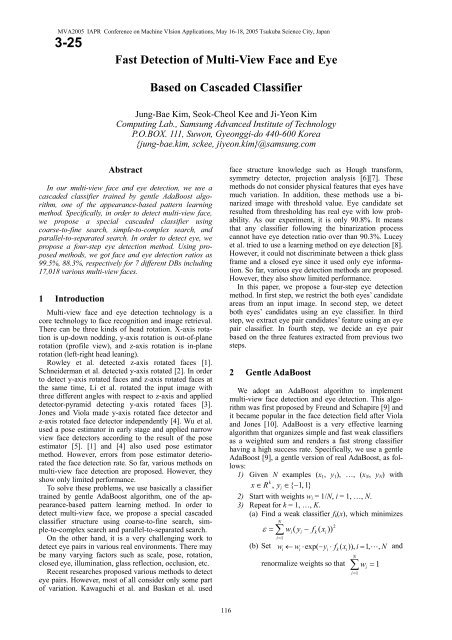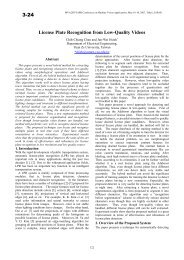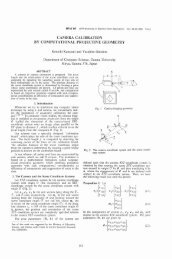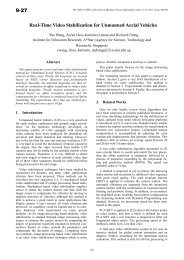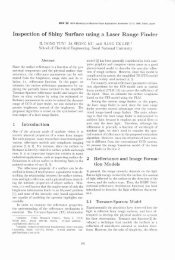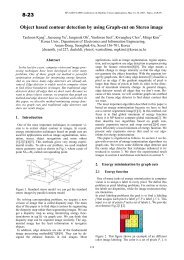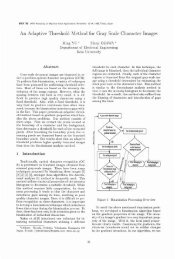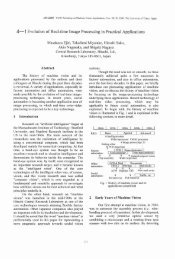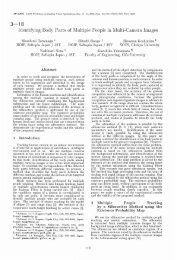Fast Detection of Multi-View Face and Eye Based on Cascaded ...
Fast Detection of Multi-View Face and Eye Based on Cascaded ...
Fast Detection of Multi-View Face and Eye Based on Cascaded ...
Create successful ePaper yourself
Turn your PDF publications into a flip-book with our unique Google optimized e-Paper software.
MVA2005 IAPR C<strong>on</strong>ference <strong>on</strong> Machine VIsi<strong>on</strong> Applicati<strong>on</strong>s, May 16-18, 2005 Tsukuba Science City, Japan3-25<str<strong>on</strong>g>Fast</str<strong>on</strong>g> <str<strong>on</strong>g>Detecti<strong>on</strong></str<strong>on</strong>g> <str<strong>on</strong>g>of</str<strong>on</strong>g> <str<strong>on</strong>g>Multi</str<strong>on</strong>g>-<str<strong>on</strong>g>View</str<strong>on</strong>g> <str<strong>on</strong>g>Face</str<strong>on</strong>g> <str<strong>on</strong>g>and</str<strong>on</strong>g> <str<strong>on</strong>g>Eye</str<strong>on</strong>g><str<strong>on</strong>g>Based</str<strong>on</strong>g> <strong>on</strong> <strong>Cascaded</strong> ClassifierJung-Bae Kim, Seok-Cheol Kee <str<strong>on</strong>g>and</str<strong>on</strong>g> Ji-Ye<strong>on</strong> KimComputing Lab., Samsung Advanced Institute <str<strong>on</strong>g>of</str<strong>on</strong>g> TechnologyP.O.BOX. 111, Suw<strong>on</strong>, Gye<strong>on</strong>ggi-do 440-600Korea{jung-bae.kim, sckee, jiye<strong>on</strong>.kim}@ samsung.comAbstractIn ourmulti-view face <str<strong>on</strong>g>and</str<strong>on</strong>g> eye detecti<strong>on</strong>, we use acascaded classifier trained by gentle AdaBoost algorithm,<strong>on</strong>e <str<strong>on</strong>g>of</str<strong>on</strong>g> the appearance-based pattern learningmethod. Specifically, in orderto detect multi-view face,we propose a special cascaded classifier usingcoarse-to-fine search, simple-to-complex search, <str<strong>on</strong>g>and</str<strong>on</strong>g>parallel-to-separated search. In orderto detect eye, wepropose a four-step eye detecti<strong>on</strong> method. Using proposedmethods, we got face <str<strong>on</strong>g>and</str<strong>on</strong>g> eye detecti<strong>on</strong> ratios as99.5%, 88.3%, respectively for7different DBs including17,018various multi-view faces.1 Introducti<strong>on</strong><str<strong>on</strong>g>Multi</str<strong>on</strong>g>-view face <str<strong>on</strong>g>and</str<strong>on</strong>g> eye detecti<strong>on</strong> technology isacore technologyto face recogniti<strong>on</strong> <str<strong>on</strong>g>and</str<strong>on</strong>g> image retrieval.There can be three kinds<str<strong>on</strong>g>of</str<strong>on</strong>g>head rotati<strong>on</strong>. X-axisrotati<strong>on</strong>isup-down nodding, y-axisrotati<strong>on</strong> isout-<str<strong>on</strong>g>of</str<strong>on</strong>g>-planerotati<strong>on</strong> (pr<str<strong>on</strong>g>of</str<strong>on</strong>g>ile view), <str<strong>on</strong>g>and</str<strong>on</strong>g> z-axisrotati<strong>on</strong> isin-planerotati<strong>on</strong> (left-righthead leaning).Rowley et al. detected z-axis rotated faces [1].Schneiderman etal. detected y-axisrotated [2]. In orderto detecty-axisrotated faces<str<strong>on</strong>g>and</str<strong>on</strong>g> z-axisrotated facesatthe same time, Li etal. rotated the inputimage withthree differentangleswith respectto z-axis<str<strong>on</strong>g>and</str<strong>on</strong>g> applieddetector-pyramid detecting y-axis rotated faces [3].J<strong>on</strong>es<str<strong>on</strong>g>and</str<strong>on</strong>g> Viola made y-axisrotated face detector<str<strong>on</strong>g>and</str<strong>on</strong>g>z-axisrotated face detectorindependently[4]. W u etal.used a pose estimatorin earlystage <str<strong>on</strong>g>and</str<strong>on</strong>g> applied narrowview face detectorsaccording to the result<str<strong>on</strong>g>of</str<strong>on</strong>g>the poseestimator [5]. [1] <str<strong>on</strong>g>and</str<strong>on</strong>g> [4] also used pose estimatormethod. However, errorsfrom pose estimatordeterioratedthe face detecti<strong>on</strong> rate. So far, variousmethods<strong>on</strong>multi-view face detecti<strong>on</strong> are proposed. However, theyshow <strong>on</strong>lylimited performance.To solve these problems, we use basicallya classifiertrained by gentle AdaBoostalgorithm, <strong>on</strong>e <str<strong>on</strong>g>of</str<strong>on</strong>g>the appearance-basedpa tern learning method. In order todetectmulti-view face, we propose a special cascadedclassifier structure using coarse-to-fine search, simple-to-complexsearch<str<strong>on</strong>g>and</str<strong>on</strong>g> parallel-to-separated search.On the otherh<str<strong>on</strong>g>and</str<strong>on</strong>g>, itisa very challenging work todetecteye pairsin variousreal envir<strong>on</strong>ments. There maybe many varying factorssuch asscale, pose, rotati<strong>on</strong>,closed eye, illuminati<strong>on</strong>, glassreflecti<strong>on</strong>, occlusi<strong>on</strong>, etc.Recentresearchesproposed variousmethodsto detecteye pairs. However, most<str<strong>on</strong>g>of</str<strong>on</strong>g>all c<strong>on</strong>sider<strong>on</strong>lysome part<str<strong>on</strong>g>of</str<strong>on</strong>g>variati<strong>on</strong>. Kawaguchi etal. <str<strong>on</strong>g>and</str<strong>on</strong>g> Baskan etal. usedface structure knowledge such as Hough transform,symmetry detector, projecti<strong>on</strong> analysis [6][7]. Thesemethodsdo notc<strong>on</strong>siderphysical featuresthateyeshavemuch variati<strong>on</strong>. In additi<strong>on</strong>, these methodsuse a binarizedimage with threshold value. <str<strong>on</strong>g>Eye</str<strong>on</strong>g> c<str<strong>on</strong>g>and</str<strong>on</strong>g>idate setresulted from thresholding hasreal eye with low probability.Asourexperiment, itis<strong>on</strong>ly 90.8%. Itmeansthatany classifierfollowing the binarizati<strong>on</strong> processcannothave eye detecti<strong>on</strong> ratio overthan 90.3%. Luceyetal. tried to use a learning method <strong>on</strong> eye detecti<strong>on</strong> [8].However, itcould notdiscriminate between a thick glassframe <str<strong>on</strong>g>and</str<strong>on</strong>g> a closed eye since itused <strong>on</strong>lyeye informati<strong>on</strong>.So far, variouseye detecti<strong>on</strong> methodsare proposed.However, theyalso show limited performance.In thispaper, we propose a four-step eye detecti<strong>on</strong>method. In firststep, we restrictthe both eyes’c<str<strong>on</strong>g>and</str<strong>on</strong>g>idateareasfrom an inputimage. In sec<strong>on</strong>d step, we detectboth eyes’c<str<strong>on</strong>g>and</str<strong>on</strong>g>idatesusing an eye classifier. In thirdstep, we extracteye pairc<str<strong>on</strong>g>and</str<strong>on</strong>g>idates’feature using an eyepairclassifier. In fourth step, we decide an eye pairbased <strong>on</strong> the three featuresextracted from previoustwosteps.2 Gentle AdaBoostWe adopt an AdaBoost algorithm to implementmulti-view face detecti<strong>on</strong> <str<strong>on</strong>g>and</str<strong>on</strong>g> eye detecti<strong>on</strong>. Thisalgorithmwasfirstproposed byFreund <str<strong>on</strong>g>and</str<strong>on</strong>g> Schapire [9]<str<strong>on</strong>g>and</str<strong>on</strong>g>itbecame popularin the face detecti<strong>on</strong> field afterViola<str<strong>on</strong>g>and</str<strong>on</strong>g> J<strong>on</strong>es[10]. AdaBoostisa very e fective learningalgorithm thatorganizessimple <str<strong>on</strong>g>and</str<strong>on</strong>g> fastweak classifiersasa weighted sum <str<strong>on</strong>g>and</str<strong>on</strong>g> rendersa faststr<strong>on</strong>g classifierhaving a high successrate. Specifically, we use a gentleAdaBoost[9], a gentle versi<strong>on</strong> <str<strong>on</strong>g>of</str<strong>on</strong>g>real AdaBoost, asfollows:1) Given N examples (x 1 , y 1 ), … , (x N , y N ) withkx R , yi{1,1}2) Startwith weightsw i = 1/N, i = 1, … , N.3) Repeatfork = 1, … , K.(a) Find a weak classifierf k (x), which minimizes Ni1w ( y fiik( x ))(b) Set w w exp(y f ( x )), i 1, Nii ii k i,renormalize weightsso that 12N w ii1<str<strong>on</strong>g>and</str<strong>on</strong>g>116
4) Output the classifier Ksign f k( x) k 1A weak classifier c<strong>on</strong>sists <str<strong>on</strong>g>of</str<strong>on</strong>g> a threshold value <str<strong>on</strong>g>and</str<strong>on</strong>g> asimple feature, as shown in Fig. 1. The specific valuesare determined according to an iterative learning. Thesimple features are designed to detect an edge or a line<str<strong>on</strong>g>of</str<strong>on</strong>g> the face easily. Several supplementary features areadded to Viola <str<strong>on</strong>g>and</str<strong>on</strong>g> J<strong>on</strong>es’ features [10].In the learning stage, all possible positi<strong>on</strong>s, sizes, <str<strong>on</strong>g>and</str<strong>on</strong>g>types <str<strong>on</strong>g>of</str<strong>on</strong>g> features are c<strong>on</strong>sidered within a 2424 window.There are a total number <str<strong>on</strong>g>of</str<strong>on</strong>g> 117,400 features with somerestricti<strong>on</strong>s to their freedom such as minimum area. Aface/n<strong>on</strong>-face str<strong>on</strong>g classifier is applied to the inputimage in all possible positi<strong>on</strong>s with all possible sizes inorder to detect all the faces with various positi<strong>on</strong>s <str<strong>on</strong>g>and</str<strong>on</strong>g>sizes.However, accordingaswerotatethesimplefeature<str<strong>on</strong>g>of</str<strong>on</strong>g>adetectorwith90°orperform amirroringoperati<strong>on</strong><strong>on</strong>thesimplefeature, wegetotherdetectors.Forexample,aleft-view detectorcanbearight-view detector.Also,12 fr<strong>on</strong>tal-view detectorscanbemadefrom <strong>on</strong>ly2 detectors.Astheresult,thenumber<str<strong>on</strong>g>of</str<strong>on</strong>g>facedetectorstobetrainedisshowninTableI.3.2 The Structure <str<strong>on</strong>g>of</str<strong>on</strong>g> <str<strong>on</strong>g>Multi</str<strong>on</strong>g>-<str<strong>on</strong>g>View</str<strong>on</strong>g> <str<strong>on</strong>g>Face</str<strong>on</strong>g> DetectorInordertodetectmulti-view face, whenweuse12 or72 facedetectorsindependently, weneed12 timesor72times<str<strong>on</strong>g>of</str<strong>on</strong>g>computati<strong>on</strong>comparingtoasinglefacedetector.Ifweadoptaposeestimator, therehappensaposeestimator’errorproblemaswementi<strong>on</strong>ed.Weproposeanew multi-view detectorbased <strong>on</strong> a specialcascadedclassifier structure using coarse-to-fine search, simple-to-complexsearch, <str<strong>on</strong>g>and</str<strong>on</strong>g> paralel-to-separated searchasshowninFig.2.(a)(b)Fig. 1. Haar-like simple features: (a) edge features;(b)line features.3 <str<strong>on</strong>g>Multi</str<strong>on</strong>g>-<str<strong>on</strong>g>View</str<strong>on</strong>g> <str<strong>on</strong>g>Face</str<strong>on</strong>g> <str<strong>on</strong>g>Detecti<strong>on</strong></str<strong>on</strong>g>3.1 Detectable Rotati<strong>on</strong> AngleFor x-axis rotati<strong>on</strong>, we need <strong>on</strong>ly 2 detectors. Theyare a down-view face detector covering [-60, -20]<str<strong>on</strong>g>and</str<strong>on</strong>g>afr<strong>on</strong>tal/upwardfacedetectorcovering[-20, 50].Fory-axisrotati<strong>on</strong>, weneed3 detectorsincludingaleft-viewfacedetector, afr<strong>on</strong>talfacedetector<str<strong>on</strong>g>and</str<strong>on</strong>g> aright-viewface detector.Theircovering anglesare [-90, -20],[-20, 20], [20, 90], respectively.Forz-axisrotati<strong>on</strong>, wedealwithalrotati<strong>on</strong>covering[-180, 180].However, duringst<str<strong>on</strong>g>and</str<strong>on</strong>g>ing, apers<strong>on</strong>canlean his/her head with [-45, 45].W e cal“Basicmode”<str<strong>on</strong>g>of</str<strong>on</strong>g>z-axisrotati<strong>on</strong>as[-45, 45]<str<strong>on</strong>g>and</str<strong>on</strong>g>“Extendedmode”<str<strong>on</strong>g>of</str<strong>on</strong>g>z-axisrotati<strong>on</strong>as[-180, 180].W hen wedesign adetectorcovering 30°<strong>on</strong> z-axisrotati<strong>on</strong>, 12 detectorscoverstheextendedmode, [-180°,180°].Forthe basic mode, 3 detectorsare sufficient.Thisiscaledas“MethodI.”W henwedesignadetectorcovers45°, 8detectorscancoverstheextendedmode.Forthebasicmode, 2 detectorsaresuficient.Thisiscaled as“Method II.”W hen wec<strong>on</strong>siderx, y, z-axisrotati<strong>on</strong>, thenumber<str<strong>on</strong>g>of</str<strong>on</strong>g>facedetectorsneededisshowninTableI.TableI.Thenumbers<str<strong>on</strong>g>of</str<strong>on</strong>g>individualfacedetectorsneededinmulti-view facedetecti<strong>on</strong>.MethodIMethodIINumber<str<strong>on</strong>g>of</str<strong>on</strong>g>faceDetectorsneeded.Number<str<strong>on</strong>g>of</str<strong>on</strong>g>facedetectorstobetrainedBasicmode 18=233 10=25Extendedmode72=2312 10=25Basicmode 12=232 6=23Extendedmode48=238 6=23(a) (b) (c)Fig.2.Threemethodsrenderingacascadedclassifierusedin the multi-view face detector;(a)Coarse-to-fine search; (b) Simple-to-complexsearch;(c)Paralel-to-separatedsearch.Coarse-to-finesearchisthatawhole-view classifierislocatedinearlystage<str<strong>on</strong>g>and</str<strong>on</strong>g>narrower-view classifiersarelocated in latestage.Simple-to-complex search isthateasierclassifiersare located in early stage <str<strong>on</strong>g>and</str<strong>on</strong>g> morecomplexclassifiersarelocatedinlatestage.Usingthesetwostages, wecanspeedamulti-view detectorupsincemostn<strong>on</strong>-facesareeliminatedinearlystages.Paralel-to-separated search isthataldetectorsarearranged in paraleluntilK stage<str<strong>on</strong>g>and</str<strong>on</strong>g> each detectorisarrangedseparatelyfrom K+1stage.Usualy, whenaninputisentered<str<strong>on</strong>g>and</str<strong>on</strong>g>afaceisdetectedsuccessfulyinacertainstage<str<strong>on</strong>g>of</str<strong>on</strong>g>aview, theinputmovest<strong>on</strong>extstage<str<strong>on</strong>g>of</str<strong>on</strong>g>thesameview tobetested.Paralelarrangementmeansthatwhenafaceisnotdetected, theinputmovestothesamestage<str<strong>on</strong>g>of</str<strong>on</strong>g>nextview.Separatedarrangementmeansthatwhenafaceisnotdetected, nomoreprocedureisneeded.Wejustdecidetheinputisan<strong>on</strong>-face.Usingthismethod, aninputimageisdecidedasacertainviewinearlystage, <str<strong>on</strong>g>and</str<strong>on</strong>g>thenwec<strong>on</strong>centrate<strong>on</strong>whethertheinputisafaceornotinlatestage.InFig.2, s st<str<strong>on</strong>g>and</str<strong>on</strong>g>sforsuccessinfacedetecti<strong>on</strong><str<strong>on</strong>g>and</str<strong>on</strong>g>f st<str<strong>on</strong>g>and</str<strong>on</strong>g>sforfailure.We combine three cascading methods into amulti-view facedetectorasshowninFig.3.In1~2 stage,whole-view faceisdetected.In3~4stage, facegroupssuchasuprightface, left-leanedface, right-leanedfacearedetected.In5~M stage, alview facearedetected.Also, paralelsearchesare implemented untilK stage<str<strong>on</strong>g>and</str<strong>on</strong>g>separatedsearchesareimplementedfrom K+1stage.InFig.3, NF st<str<strong>on</strong>g>and</str<strong>on</strong>g>sforn<strong>on</strong>-face, s st<str<strong>on</strong>g>and</str<strong>on</strong>g>sforsuccessinfacedetecti<strong>on</strong>, <str<strong>on</strong>g>and</str<strong>on</strong>g>f st<str<strong>on</strong>g>and</str<strong>on</strong>g>sforfailure.117


